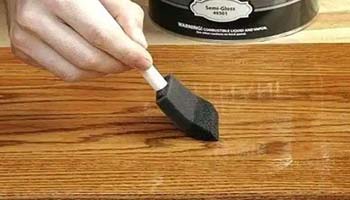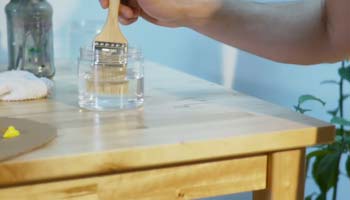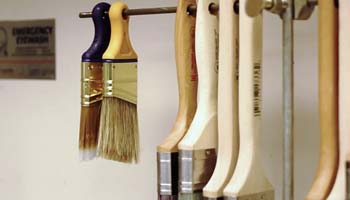How To Clean A Brush With Polyurethane
It feels fantastic when you are finally done painting your furniture, wall, or your dinner table. But now you realize that you've made a mess while painting, and your brush has polyurethane on it.
And you can't just leave your brush like that because it'll start to harden up and only make things worse.
But don't worry, we'll go through a couple of methods that will teach you how to clean polyurethane off brush, so no need to throw them away.
What are The Different Types of Polyurethane?
Polyurethane coating is a layer in the form of a liquid that is used in sealants, varnishes, bookcases, bedding, and family frames. Also, polyurethane dries faster, and when you let it dry, it won't go back to its liquid form even if you hold it to heat and chemicals.
But before we try to remove polyurethane from your brush, we need to understand the different types of polyurethane.
There are two types of polyurethane. Oil-based and water-based. Understanding which one you used will help you remove polyurethane from your brush.
Type 1: Water-Based Polyurethane

Water-based polyurethane has gained a lot of popularity over the years because of its low odor, low toxicity, and how easy it is to remove compared to oil-based ones. Unlike oil-based polyurethane, water-based polyurethane does not add color to the wood and will preserve its natural tone.
Water-based polyurethane is also less toxic than oil-based polyurethane. However, it should still be used with caution.
Type 2: Oil-Based Polyurethane
Oil-based polyurethane is a little more durable than water-based, and it's also cheaper. But if you're using it — you need to keep windows open and fans running for a few days, the odor can settle into curtains, beds, and clothing.
How to Clean Polyurethane Brush - 2 Simple Methods?
Methods may be different depending on the type of polyurethane you used. If you used water-based polyurethane, then pouring water on it will do the job. On the other hand, if you used oil-based polyurethane, there are a few methods you must follow to get to the final result.
But don't worry, we went in-depth and made it as simple as possible for you to clean your brush.
Method 1: How to Remove Water-Based Polyurethane from Your Brush?
Water-based polyurethane is the easiest one to remove from your brush. All you need is water and a cup to soak the brush into the cup to clean the brush after polyurethane paint.
Soak Your Brush in Water
Before doing this, read the back of the can where it says if it's a water-based polyurethane or oil-based. If it says water-based, then you're good to go. Otherwise, skip this method and go straight to the next one as this method will do nothing for your brush.
What You Will Need
- A couple of cups to rinse the water
Steps to Take
- Get a cup and fill it with water.
- Soak the brush into the cup.
- Spill out the old water.
- Fill it again.
- Do this about four times.
- You know you're done when water turns clean.
Head Over to Your Sink
If there is still some paint residue on your brush, you may want to wash it in your sink to get rid of it.
- Wear gloves to protect your hands.
- Turn on the water.
- Be careful when doing this, you don't want to get paint splatters all over the place.
- Wring it out as much as you can.
Method 2: How to Remove Oil-Based Polyurethane from Your Brush?
Removing oil-based polyurethane may take more steps than water-based polyurethane — but it's not rocket science. All you need is paint thinner, water, dish soap, and be patient in the process.
We also recommend wearing a dust mask and gloves. You should also keep the windows open when dealing with oil-based polyurethane to protect yourself. If you can, go outside when doing so.
Using Paint Thinner
A paint thinner is a solvent used to remove polyurethane from a brush. You can purchase it at your local hardware store.
Before using paint thinner — we recommend keeping windows open, wearing a dust mask, and gloves to prevent paint thinner poisoning.
Steps to Take
- Add a small amount of paint thinner to the cup.
- Do not fill it to the top.
- Dip the brush into the cup of paint thinner.
- Leave the brush in the cup for about 20 minutes.
- Bend the brush side to side.
- Bend it enough to get it up to the metal part. Otherwise, the brush will harden up.
- Do not jam it straight down.
- Wring it out as best as you can.
- Do it until the paint thinner turns clean.
Wash Out the Paint Thinner

Now that we have kind of cleaned the brush, there is just one more step to remove polyurethane from the brush.
Steps to Take
- Go to your sink.
- Wear gloves to protect your skin from losing its natural oils.
- Pour dish soap onto the brush.
- Work the dish soap into the bristles.
- Turn on the water.
- Rinse it out as much as you can.
- Rub it against your hand, and if it lathers up, you're pretty much done.
- Get the soap out of it.
- Keep flushing it with water until you see no soap bubbles left in its bristles.
Drying Your Brush
Now that you have gotten the soap off your brush, we need to dry it properly to prevent it from hardening up.
Steps to Take
- Get a microfiber brush to clean polyurethane brush
- Wipe it over the bristles
- Do this until the brush no longer drips
Where to Store Brushes?
After going through all this process, there is just one more thing you need to do to protect your brush and increase its longevity with proper maintenance techniques.
If your brush dries out with paint on it, it won't be capable of putting a smooth coat of paint, and you will have to buy a new one. This is an endless loop if you don't take proper measures.
Storing your brush should be the number one thing that goes through your mind after you are done painting. It is not surprising to have a brush lasting for 10 years despite it being used quite frequently.
While it is true that depending on the quality of your brush, longevity may vary. There are some things that you can do to preserve your brush.
Storing Your Brush
You've been working a massive project for the past 5 hours, and you just want to take a small break from painting.
So, you decide to lay the brush on a newspaper or a rag until you come back. But just placing the brush on a rag isn't enough, and you probably shouldn't do that as it could damage your brush.
There are better ways to store and preserve your brush when taking a break, and they will make cleaning polyurethane brush a lot easier.
- Leave one-third of the bristles in the paint before you go take a break.
- Doing so will prevent the brush from hardening up by the time you come back from taking a break.
Taking a Long Break
Leaving the brush inside the paint only works if you are going to take a small break, but what if you want to take an extended break?
Some people may wrap their brush around plastic only to realize that the brush dried out and got stuck to the plastic.
Wrapping your brush around plastic doesn't work for a couple of reasons:
- The excessive air in the bag causes the brush to harden up.
- The plastic wrap allows moisture and solvents on the brush, causing it to harden up.
So, what is the best alternative to plastic? Aluminum foil is by far the easiest and most effective way to prevent your brush from drying out.
- Wrap the brush you want to preserve.
- Make sure the aluminum covers the brush.
- Cut off the additional portions that you're not going to use.
Tips To Cleaning and Storing Your Brush for Future Use

To prevent any damage on your brush after painting — you need to properly store it and clean it to extend its longevity.
Steps to Take
- Clean the brush right after using it to stop it from drying out.
- Clean the brush thoroughly. If you used water-based polyurethane, then simply using dish soap and water will do the trick.
- If you used oil-based polyurethane — you want to use paint thinner to remove any residue.
- Wring it out before storing it.
- Wrap the brush.
Final Words
As you can see, how to clean a polyurethane brush is not that hard, and it only takes a few steps to get your brush back to normal. All you need is water or paint thinner depending on the type of polyurethane you used. And then, use soapy water and water to flush it.
If you keep it clean and follow all the steps we mentioned before, your brush will last for many years. So, it's worth the time.
We recommend doing this right after you're done painting to stop the brush from hardening up. So, next time you use it, it'll be in great shape for your project.
How To Clean A Brush With Polyurethane
Source: https://www.ronaldphillipsantiques.com/how-to-clean-polyurethane-brush/
Posted by: albrechtfait1939.blogspot.com

0 Response to "How To Clean A Brush With Polyurethane"
Post a Comment